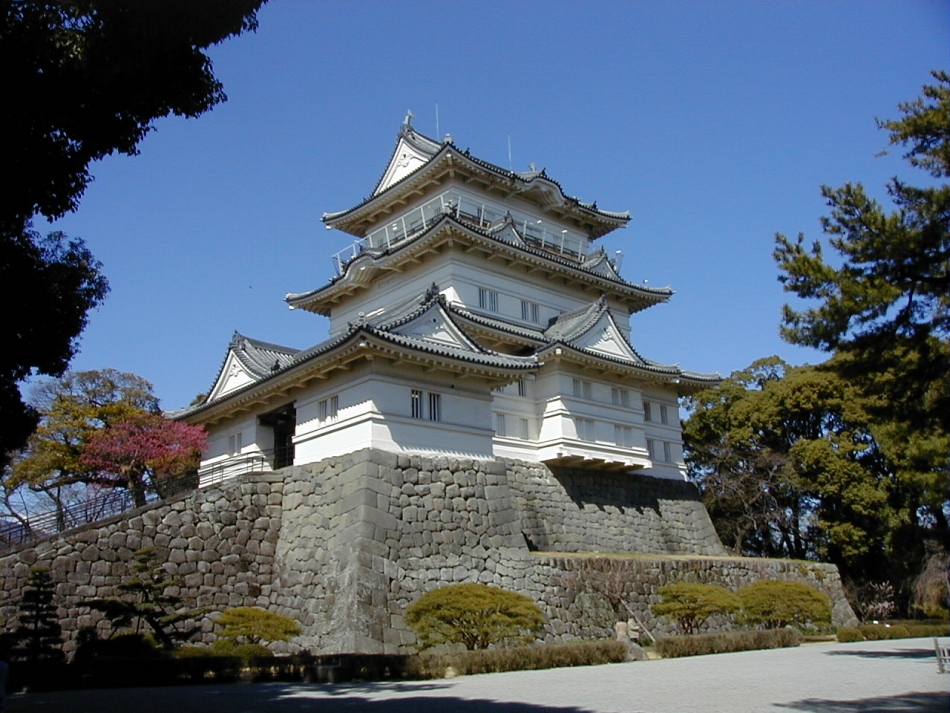最終更新日:2016年04月08日
Odawara Castle, Symbol of Odawara
Various resources developed over several eras, centering on Odawara Castle, have given rise to the town of Odawara. Let’s cast our thoughts back to antiquity and get a feel for the history that has been passed down to us.
Donjon
The castle’s predecessor was a castle built on a hill by the Omori clan in the Muromachi era (1338–1573), and after becoming the seat of Odawara Hojo clan in the Warring States period, it was expanded as a base from which to control the Kanto region. The donjon is a 1960 reproduction of its appearance at the end of the Edo era. The three-tiered, four-story keep is equipped with attached and connecting gallery turrets and suits of armor, swords, and old documents and other historical materials are on exhibit inside. The uppermost floor overlooks Sagami Bay and the city.
Hours |
9 a.m. to 5 p.m. (doors close at 4:30 p.m.) |
|---|---|
Admission |
Adults, ¥500; elementary and junior high school students, ¥200 (joint admission passes for the Rekishi-Kenbunkan museum are also available) |
Closed |
Second Wednesday in December, December 31 and January 1 |
Odawara Castle Park
With the donjon that stands in the inner citadel as its centerpiece, Castle Park is a leisure spot for city residents and sightseers that is known for its flowers, including plums, cherries, and hydrangeas. The Tokiwagi and other castle gates and Umaya Bailey were rebuilt after the donjon was reconstructed. Most of the inner and outer citadels and part of the outer walls have been designated as national historical sites. Vestiges of the Edo period, including the site of Ote-mon Gate and the former site of Kodaguchi-mon Gate, remain throughout the vicinity.
Castle Gates (Umadashi, Akagane, and Tokiwagi)
Pass through the Umadashi-mon Gate, which serves as Odawara Castle’s main entrance, and Akagane-mon Gate, named for the decorative copper fittings on its large doors, is a bit further on. Proceeding on through the second citadel from Akagane-mon Gate, the inner citadel’s main gate, Tokiwagi-mon Gate, awaits. As the most important location for the castle’s defense, this gate was built solidly and was given the its name, “evergreen,” in wishes for prosperity that would be as everlasting as the ever green color of the old black pine tree next to the gate.
Rekishi-Kenbunkan Museum
This information center provides audio-visual enjoyment of Odawara Castle’s history, giving visitors the impression of having slipped back in time to the Warring States or Edo period.
Hours |
9 a.m. to 5 p.m. (doors close at 4:30 p.m.) |
|---|---|
Admission |
Adults, ¥300; elementary and junior high school students, ¥100 (joint admission passes for the donjon are also available) |
Closed |
December 31 and January 1 |
Trivia One more castle that was located in Odawara—“one night castle”
Ishigakiyama Ichiyajo Historical Park
The site of the castle that served as Toyotomi Hideyoshi’s headquarters when he laid siege to Odawara in 1590 is now a historical park. Parts of the stacked stone walls, consisting of simple stacks of unaltered stones, which bring back memories of ancient times, and the area in which the well was located remain. The site overlooks Odawara Castle and also affords a panoramic view that takes in an area stretching from the Miura Peninsula to the Boso Peninsula, as well as Tokyo Skytree if conditions are right.
Access |
A 40-minute walk from JR Hayakawa Station or a 50-minute walk from Hakone Tozan Line Iriuda Station |
|---|
この情報に関するお問い合わせ先
経済部:観光課 観光振興係
電話番号:0465-33-1521
)
